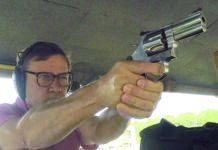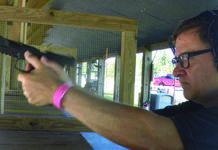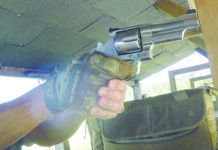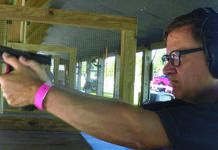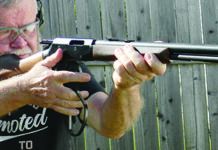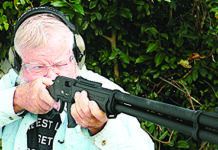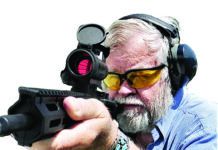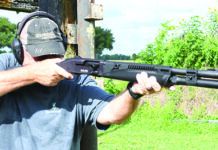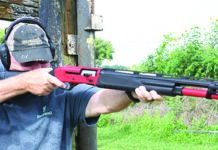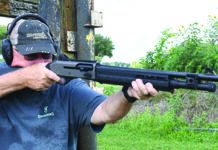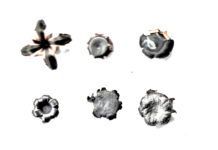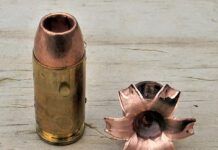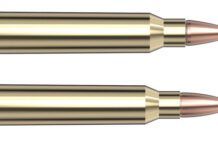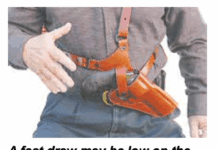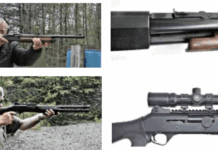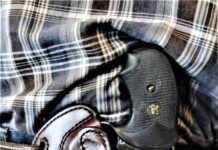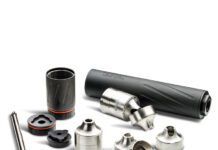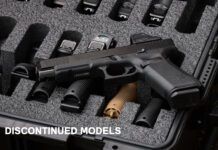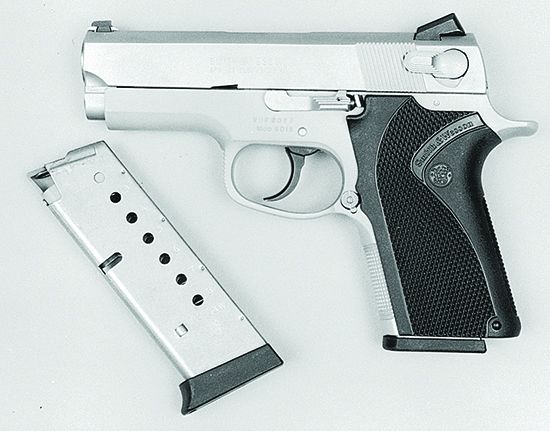In the January 1996 issue, we tested a quartet of 40-caliber semi-autos, three of which had significant drawbacks, our shooters said. In this installment of Gun Tests Classics, we revisit the winner of that test, a Smith & Wesson Model 4013, and see if its current used pricing makes it a still-valid recommendation for today’s shooters.
In the 1996 test, we fired four compact 40 S&W pistols head-to-head. They were a Glock 27, a Smith & Wesson Model 4013, a European American Armory Witness Compact, and an AMT DAO Back-up. Here’s a quick recap of the losers in that test:
● During firing, the EAA Witness Compact misfed about 13 percent of the time with all three brands of ammunition we used. These malfunctions appeared to be caused by the magazine follower’s inability to consistently keep the top cartridge’s nose raised enough to feed properly.
● The Glock 27’s functioning wasn’t perfect. In the first 200 rounds, its slide failed to return forward far enough to lock four times. Although skilled shooters shouldn’t have a problem with this gun, we didn’t recommend it for those who are prone to limp-wristing pistols.
● The AMT 40 S&W DAO Back Up misfed 19 times, and the slide failed to fully close 11 more times. Most of these failures occurred while attempting to fire the last round in the magazine.
The winner of the test, Smith & Wesson’s Model 4013, is a compact 40 S&W pistol with a stainless-steel slide assembly and an alloy frame. It features a traditional double-action trigger, a slide-mounted decocking safety and a single-column magazine. Although this gun is 5⁄8-inch longer, 11⁄8-inch taller and 71⁄2 ounces heavier than the Glock 27 we covered, its capacity and barrel length are the same.
The $722 (1996 price) Model 4013 we bought for this test had a frosted silver-white frame, while the slide and barrel were frosted silver-gray. The trigger and spurless hammer were dull blue/black. All three finishes were uniformly done, and the barrel’s chamber face and feed ramp were brightly polished. However, we did note a few minor tool marks on the interior of the slide. Contours transitioned smoothly, and moving parts had almost no play.
Like most Smith & Wesson Third Generation semiautos, the pistol had a one-piece grip made of black plastic with a lightly textured finish. It wrapped around and constituted the frame’s backstrap. The grip was mated closely to the frame. One of the single-column magazines provided with the gun had an extended black-plastic floorplate that doubled as a finger rest, while the other had a low-profile floorplate. Both eight-rounders also featured stainless steel bodies and red plastic followers. Neither had any shortcomings.
Thanks to the muzzle heavy Model 4013’s straight backstrap, it pointed naturally. Consequently, target acquisition and muzzle stability were very good. Shooters with small- and medium-sized hands found the grip long enough for three fingers, and those with large hands appreciated the magazine with the extended floorplate. All considered the shape of the grip and tang to be comfortable. The well-molded checkering on the sides and back of the grip as well as on the alloy frontstrap afforded a secure grasp. Although this .40 S&W generated less felt recoil than the others included here, muzzle flip was still stout.
Most of this Smith & Wesson’s controls were ambidextrous. The magazine-release button at the left rear of the trigger guard was reversible and operated readily. Right-handed shooter’s could reach the slide-catch lever on the left side of the frame with their dominant thumb, but two fingers were needed to depress it. The safety featured dual two-position levers on the slide. When moved downward, it disconnected the trigger, blocked the firing pin and decocked the hammer. All of the pistol’s safeties, including the passive firing-pin block and the magazine disconnect, worked well.
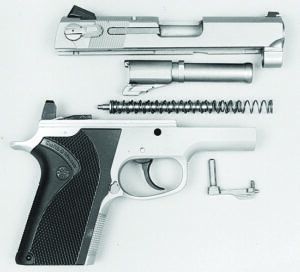
Cocking the hammer manually must be done very carefully to prevent an accidental discharge. To do so, slowly pull the trigger back until the hammer is exposed enough to hold it with the thumb of your support hand, take your finger completely off the trigger (allowing the passive firing-pin block to do its job), then fully cocked the hammer.
To field-strip the Model 4013, begin by removing the magazine and unloading the chamber. Pull the slide rearward until the takedown notch on the left side of the slide aligns with the front, rounded portion of the slide catch. Remove the slide-catch lever from the frame by pushing it out from right to left, then guide the slide assembly forward off the frame. Compress the non-captive recoil assembly slightly, then withdraw it from the slide. Pull the barrel up and out of the slide.
Although reassembly is done in reverse order, a few additional steps must be performed. Before you begin, ensure that the hammer is uncocked. When installing the slide onto the frame, push the ejector, sear release and firing-pin safety levers down out of the way.
Our test gun digested everything we gave it without incident. However, we had to muscle the last (eighth) round into both magazines. Both magazines also hung up on the magazine catch inside the well during insertion, but each dropped out freely when released. Although this model’s non-captive recoil assembly had two springs, fully retracting the smooth-operating slide required only a little more muscle than on a full-size 40 S&W.
This Smith & Wesson’s ungrooved 5⁄16-inch-wide trigger had an overly heavy single-action pull. After about a quarter-inch of slack, it released at 7.25 pounds. However, the smooth double-action pull let-off cleanly at 12.5 pounds.
Despite this pistol’s stainless-steel construction, its fixed sights were made of steel with a matte blue/black finish. The dovetailed front was a patridge-type blade with a large, white dot on its face. The rear consisted of a Novak-style blade with a small, white dot on either side of its square notch.
Of the 40 S&W pistols in this test, the Model 4013 was the most accurate. We produced the smallest five-shot groups, which averaged 2.30 inches at 15 yards, using Winchester 155-grain Silvertips. With Remington 180-grain jacketed hollowpoints, groups opened up to 2.60 inches. Muzzle velocities of these gun and load combinations, which averaged from 955 to 1139 fps, were the fastest of the test.
Bottom Line: The Smith & Wesson Model 4013’s easier handling, ambidextrous operation and above-average accuracy make it a good choice for most concealed-carry shooters. The Standard Catalog of Firearms lists this one for $600 in Excellent condition, and Blue Book of Gun Values has it for $595 in 100% condition. At those prices, we think the Smith & Wesson Model 4013 is still a good buy.
Adapted by Gun Tests Staff, using evaluations from Gun Tests Team members. GT



